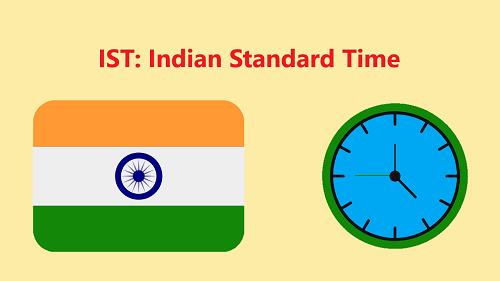Indian Standard Time (IST) is the time standard used in India and is the full form of “IST.” It is the time at which the standard meridian (a reference longitude) and the local time at that meridian are considered the official standard time for the entire country.

How IST Works
- Indian Standard Time (IST) operates as a timekeeping system that unifies the diverse regions of India under a single time standard. The foundation of IST lies in the selection of the 82.5 degrees east longitude, which runs near the city of Allahabad (now Prayagraj), as the standard meridian. This meridian serves as the reference point for timekeeping in India.
- The local time at this standard meridian is considered the official time for the entire country. Despite India’s significant east-west geographic spread, all regions across the nation adhere to IST to maintain uniformity.
- This simplifies communication, scheduling, and coordination, ensuring that everyone operates on the same clock, even though some areas are geographically positioned to the east of the standard meridian. IST does not observe Daylight Saving Time, so it remains consistent throughout the year, contributing to efficiency and consistency in daily activities and interactions nationwide.
Why are Revolutions per minute important?
- Indian Standard Time (IST) and Coordinated Universal Time (UTC) are two distinct time standards used globally. IST is the official time in India, with a standard meridian at 82.5 degrees east. It is UTC+5:30, meaning it is 5 hours and 30 minutes ahead of UTC. In contrast, UTC is the world’s primary time standard, serving as a reference for timekeeping worldwide.
- UTC is based on highly precise atomic clocks and is not subject to time zone variations. The key difference lies in UTC’s universality and precision, as it remains constant and is independent of geographical regions. In contrast, IST is specific to India and is used to maintain a uniform time standard across the country’s vast expanse.
- While IST simplifies daily life within India, UTC is crucial for global communication, international travel, and synchronization of events worldwide. It serves as the basis for coordinating activities such as aviation, satellite communication, and financial transactions that require precise timing across borders.
Importance of IST
Indian Standard Time (IST) is crucial for India’s uniformity, efficiency, and national integration. It simplifies scheduling and communication, fosters unity among diverse regions, ensures seamless nationwide communication, aids legal and administrative functions, supports scientific research, and facilitates efficient emergency services. IST is the backbone of India’s coordinated and productive functioning.
IST in Different Regions of India
- Indian Standard Time (IST) is the respectable time standard for the complete United States of America of India, and it is observed uniformly throughout all regions. Regardless of the geographic place within India, equal time is found.
- This uniformity simplifies everyday existence, verbal exchange, and coordination throughout the kingdom, making sure that everyone operates on the same clock.
- Unlike some nations with more than one time zone, India’s widespread expanse is protected with the aid of an unmarried time sector, making IST the standard time from the westernmost place in Gujarat to the easternmost region in Arunachal Pradesh.
- This method gets rid of the need to regulate clocks when touring inside the u. S . And allows preserving consistency in diverse activities and offerings, from commercial enterprise and transportation to governance and amusement.
Conclusion
In conclusion, Indian Standard Time (IST) is the official time standard for the entire nation of India. It provides a consistent and uniform time reference across all regions, from the westernmost to the easternmost parts of the country. IST plays a vital role in simplifying daily life, communication, and coordination, making it an essential element of India’s diverse and populous nation.
FAQ's About IST
IST is based on the standard meridian at 82.5 degrees east longitude, which runs near the city of Prayagraj (formerly Allahabad).
Yes, IST is uniform across all regions of India. Regardless of the geographical location within the country, the same time is observed.
IST is typically UTC+5:30, meaning it is 5 hours and 30 minutes ahead of Coordinated Universal Time (UTC).
No, IST does not observe Daylight Saving Time. The time remains consistent throughout the year.
Related posts:
- AMC Full Form: Benefits, Components, Needs, Advantage
- ORS Full Form: Dehydration, Myths, Flavors, Varieties & Facts
- PCC Full Form: Importance, Types, Application Process
- PAN Full Form: Legal Provisions, Regulations,
- BRB Full Form: Productive, Routine, Distractions
- MCD Full From: Introduction, Responsibility, Challenges
- CT Scan Full Form: Scans, price, Advantages
- USA Full Form: History, Economics,Technology, culture




















